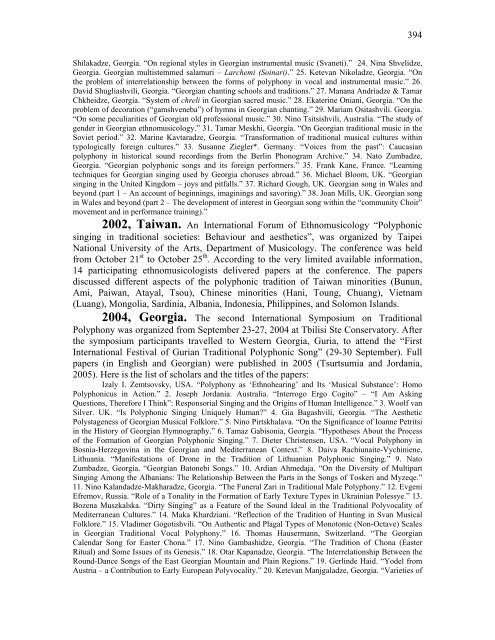who asked the first question? - International Research Center For ...
who asked the first question? - International Research Center For ...
who asked the first question? - International Research Center For ...
You also want an ePaper? Increase the reach of your titles
YUMPU automatically turns print PDFs into web optimized ePapers that Google loves.
394Shilakadze, Georgia. “On regional styles in Georgian instrumental music (Svaneti).” 24. Nina Shvelidze,Georgia. Georgian multistemmed salamuri – Larchemi (Soinari).” 25. Ketevan Nikoladze, Georgia. “On<strong>the</strong> problem of interrelationship between <strong>the</strong> forms of polyphony in vocal and instrumental music.” 26.David Shugliashvili, Georgia. “Georgian chanting schools and traditions.” 27. Manana Andriadze & TamarChkheidze, Georgia. “System of chreli in Georgian sacred music.” 28. Ekaterine Oniani, Georgia. “On <strong>the</strong>problem of decoration (“gamshveneba”) of hymns in Georgian chanting.” 29. Mariam Ositashvili. Georgia.“On some peculiarities of Georgian old professional music. ” 30. Nino Tsitsishvili, Australia. “The study ofgender in Georgian ethnomusicology.” 31. Tamar Meskhi, Georgia. “On Georgian traditional music in <strong>the</strong>Soviet period.” 32. Marine Kavtaradze, Georgia. “Transformation of traditional musical cultures withintypologically foreign cultures.” 33. Susanne Ziegler*. Germany. “Voices from <strong>the</strong> past”: Caucasianpolyphony in historical sound recordings from <strong>the</strong> Berlin Phonogram Archive.” 34. Nato Zumbadze,Georgia. “Georgian polyphonic songs and its foreign performers.” 35. Frank Kane, France. “Learningtechniques for Georgian singing used by Georgia choruses abroad.” 36. Michael Bloom, UK. “Georgiansinging in <strong>the</strong> United Kingdom – joys and pitfalls.” 37. Richard Gough, UK. Georgian song in Wales andbeyond (part 1 – An account of beginnings, imaginings and savoring).” 38. Joan Mills, UK. Georgian songin Wales and beyond (part 2 – The development of interest in Georgian song within <strong>the</strong> “community Choir”movement and in performance training).”2002, Taiwan. An <strong>International</strong> <strong>For</strong>um of Ethnomusicology “Polyphonicsinging in traditional societies: Behaviour and aes<strong>the</strong>tics”, was organized by TaipeiNational University of <strong>the</strong> Arts, Department of Musicology. The conference was heldfrom October 21 st to October 25 th . According to <strong>the</strong> very limited available information,14 participating ethnomusicologists delivered papers at <strong>the</strong> conference. The papersdiscussed different aspects of <strong>the</strong> polyphonic tradition of Taiwan minorities (Bunun,Ami, Paiwan, Atayal, Tsou), Chinese minorities (Hani, Toung, Chuang), Vietnam(Luang), Mongolia, Sardinia, Albania, Indonesia, Philippines, and Solomon Islands.2004, Georgia. The second <strong>International</strong> Symposium on TraditionalPolyphony was organized from September 23-27, 2004 at Tbilisi Ste Conservatory. After<strong>the</strong> symposium participants travelled to Western Georgia, Guria, to attend <strong>the</strong> “First<strong>International</strong> Festival of Gurian Traditional Polyphonic Song” (29-30 September). Fullpapers (in English and Georgian) were published in 2005 (Tsurtsumia and Jordania,2005). Here is <strong>the</strong> list of scholars and <strong>the</strong> titles of <strong>the</strong> papers:Izaly I. Zemtsovsky, USA. “Polyphony as ‘Ethnohearing’ and Its ‘Musical Substance’: HomoPolyphonicus in Action.” 2. Joseph Jordania. Australia. “Interrogo Ergo Cogito” – “I Am AskingQuestions, Therefore I Think”: Responsorial Singing and <strong>the</strong> Origins of Human Intelligence.” 3. Woolf vanSilver. UK. “Is Polyphonic Singing Uniquely Human?” 4. Gia Bagashvili, Georgia. “The Aes<strong>the</strong>ticPolystageness of Georgian Musical Folklore.” 5. Nino Pirtskhalava. “On <strong>the</strong> Significance of Ioanne Petritsiin <strong>the</strong> History of Georgian Hymnography.” 6. Tamaz Gabisonia, Georgia. “Hypo<strong>the</strong>ses About <strong>the</strong> Processof <strong>the</strong> <strong>For</strong>mation of Georgian Polyphonic Singing.” 7. Dieter Christensen, USA. “Vocal Polyphony inBosnia-Herzegovina in <strong>the</strong> Georgian and Mediterranean Context.” 8. Daiva Rachiunaite-Vychiniene,Lithuania. “Manifestations of Drone in <strong>the</strong> Tradition of Lithuanian Polyphonic Singing.” 9. NatoZumbadze, Georgia. “Georgian Batonebi Songs.” 10. Ardian Ahmedaja. “On <strong>the</strong> Diversity of MultipartSinging Among <strong>the</strong> Albanians: The Relationship Between <strong>the</strong> Parts in <strong>the</strong> Songs of Toskeri and Myzeqe.”11. Nino Kalandadze-Makharadze, Georgia. “The Funeral Zari in Traditional Male Polyphony.” 12. EvgeniEfremov, Russia. “Role of a Tonality in <strong>the</strong> <strong>For</strong>mation of Early Texture Types in Ukrainian Polessye.” 13.Bozena Muszkalska. “Dirty Singing” as a Feature of <strong>the</strong> Sound Ideal in <strong>the</strong> Traditional Polyvocality ofMediterranean Cultures.” 14. Maka Khardziani. “Reflection of <strong>the</strong> Tradition of Hunting in Svan MusicalFolklore.” 15. Vladimer Gogotishvili. “On Au<strong>the</strong>ntic and Plagal Types of Monotonic (Non-Octave) Scalesin Georgian Traditional Vocal Polyphony.” 16. Thomas Hausermann, Switzerland. “The GeorgianCalendar Song for Easter Chona.” 17. Nino Gambashidze, Georgia. “The Tradition of Chona (EasterRitual) and Some Issues of its Genesis.” 18. Otar Kapanadze, Georgia. “The Interrelationship Between <strong>the</strong>Round-Dance Songs of <strong>the</strong> East Georgian Mountain and Plain Regions.” 19. Gerlinde Haid. “Yodel fromAustria – a Contribution to Early European Polyvocality.” 20. Ketevan Manjgaladze, Georgia. “Varieties of
















